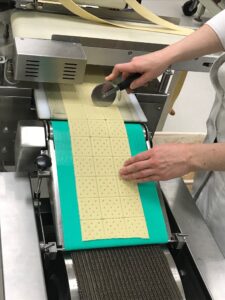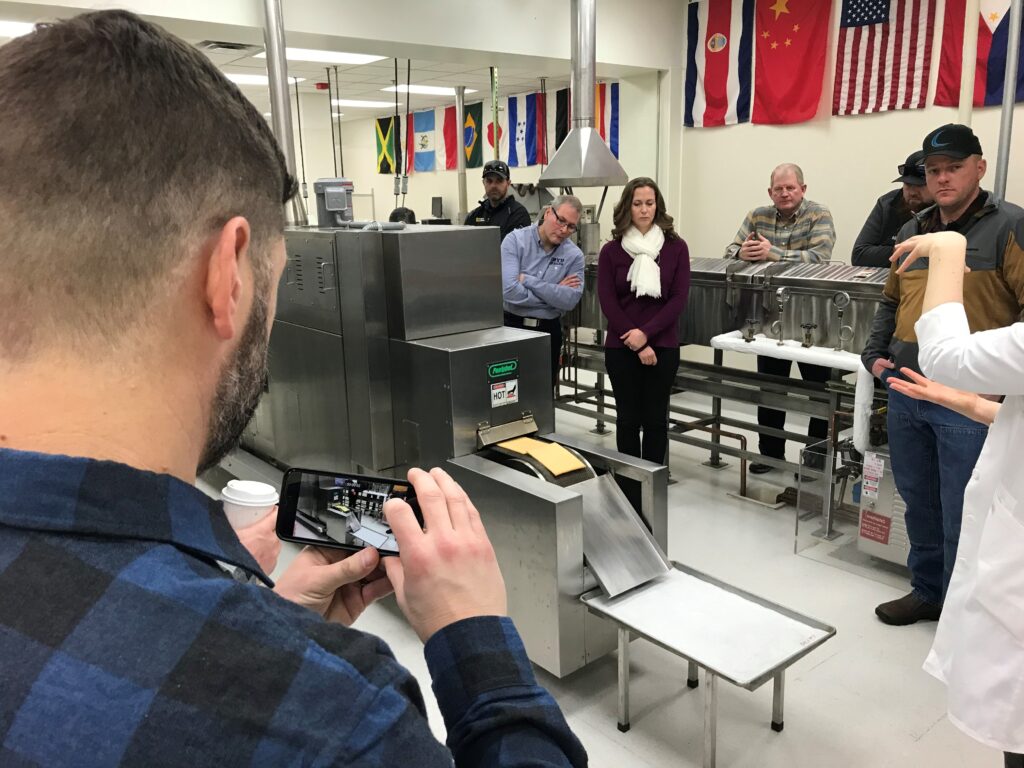Cracker, cookie or biscuit: In the U.S., we refer to savory products as crackers and sweet products as cookies. In much of the world, these same products are generally known as biscuits and are divided into savory and sweet types.
By Janice Cooper

Ten years ago at the Tri-State Commission meeting, the three states agreed to support the purchase of a new, pilot-scale line for cracker and biscuit research and training at the Wheat Marketing Center (WMC) in Portland. Long promoted by former Washington Grain Commission (WGC) CEO Tom Mick and other Pacific Northwest (PNW) wheat leaders, the concept finally became reality. Designed by U.S. Wheat Associates Baking Consultant Roy Chung and built by Poolphol Engineering in Bangkok, Thailand, with substantial financial support from the PNW states, Montana and North Dakota, the new cracker line provided the WMC a unique tool for training, research and product development. The equipment was installed in June of 2013.
According to current WGC CEO Glen Squires, cracker/biscuit consumption around the world is so large that it made sense to promote PNW soft white wheat for use in these products.
“We heard from customers that new product development was very disruptive to the manufacturing process,” he recalls.
The WMC’s technical team, led by Dr. Jayne Bock, utilizes the cracker line in three main ways: technical training/education, research and new product development.
“We have had multiple cracker projects and workshops every year since my arrival in 2018,” Bock said. “It is a popular pilot line with companies and customers because of its flexibility, quick production time and small batch sizes. We can run more than 60 batches in a week, allowing us to compare a complex array of products, flour blends, ingredients and processing conditions.”
Technical training and grower education
Starting in December 2013, WMC has offered technical training courses built around the cracker line. The early courses enabled customers of U.S. wheat from around the world to evaluate different flour blends (including soft white wheat) and ingredients to improve the products preferred by their local consumers. The use of whole wheat was also explored by a Korean baking team, and one of the participating companies released a popular grain bar as a result.
In addition to technical training, the cracker line is a popular feature in the workshops held at WMC for wheat producers from different states. As the dough moves through the process of lamination, cutting and
baking, Bock explains each step and talks about optimal flour blends and the role of various ingredients. As they enjoy the warm crackers, participants gain a helpful understanding of another piece in the wheat value chain.

Center in Portland. Photo courtesy of the Wheat Marketing Center.
Research
WMC technical staff and visiting scholars have conducted multiple public research projects on cracker-related topics, including optimal protein levels and options for improving soft white performance in saltine crackers and whole wheat flour formulations. These results are published on the WMC website, wmcinc.org. WMC also conducts proprietary research for clients to evaluate the impact of ingredients (like different types of yeast) and processing conditions on cracker quality. Consistency in cracker size and thickness is key in commercial production.
Product development
Commercial cracker lines are many times larger than the pilot-scale line and produce thousands of crackers each hour. In order to try new products to meet changing consumer demands for new flavors, lower salt or sugar or different shapes, companies have to halt production to run the experimental product. For companies interested in trying soft white wheat in their crackers, this was a major barrier. The cracker line offers an excellent alternative as an offsite research and development lab. Access to WMC technical expertise and the unique pilot line has helped expand the use of PNW soft white wheat in new products and in new markets.
WMC Board Chair Bill Flory, an Idaho wheat producer, gives credit to PNW wheat producers who had the vision and commitment to bring the concept of a pilot-scale cracker line to fruition.
“By understanding the needs of our customers and seeing the opportunity to provide technical assistance, the PNW commissions partnered with the Wheat Marketing Center to offer this solution,” Flory said. “The cracker line is enjoying frequent and diverse utilization and continues to provide an excellent return on the growers’ investment.”
Attendees at this year’s Tri-State Grain Growers Convention found some special crackers in their welcome bags made with PNW wheat with a little spice added.
This article originally appeared in the November 2021 issue of Wheat Life Magazine.

Janice Cooper
Janice Cooper is the managing director of the Wheat Marketing Center in Portland, Oregon, a position she has held since November 2015. Prior to joining the WMC, she served for six years as executive director of the California Wheat Commission and earlier managed the California Association of Wheat Growers. In addition to her experience in the wheat industry, Janice has a broad background in business development and trade policy in the banking, high tech and renewable energy sectors. Janice started her career in Washington, D.C., as a staff member in the U.S. Senate. She returned to D.C. later as the trade representative for the State of California.
